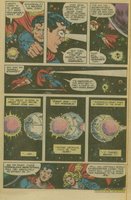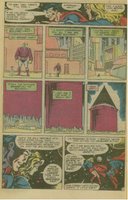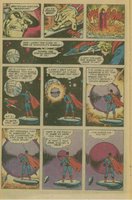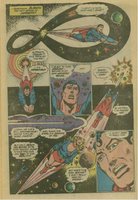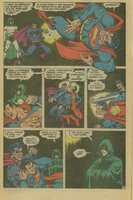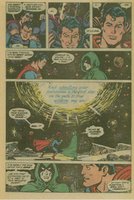First up is Batman #649 (written by Judd Winick, pencilled by Eric Battle, inked by Rodney Ramos). In this issue we get to watch Batman, the Red Hood, the Joker, and Black Mask each psychoanalyze each other while they try to figure out whether the Red Hood is dead or whether the Joker soon will be. I thought Winick did a good job keeping the tension going, and for the first time I really believed that this was Jason Todd back from the dead -- and it didn't make me entirely sick. The guest artists did well, too, although Mahnke and Nguyen had quietly established themselves as good Batman artists in their own right. I'll be sorry to see them all go.
I don't have much in the way of specific cheers and boos for Green Lantern Corps: Recharge #4 (written by Dave Gibbons and Geoff Johns, pencilled by Patrick Gleason, inked by Prentiss Rollins), except to say that I liked it too. There were a few points during the more complex fight scenes where I felt Gleason dropped the ball, specifically in a last-minute rescue situation where everyone turns out OK, but the reader's not sure how. Anyway, dialogue was good here too, and the book was an entertaining space opera featuring a handful of Green Lanterns against alien spider bad guys. As much as I'd like a Green Lantern Corps book to tackle more cerebral issues of jurisdiction and due process, fighting the Spider Guild has a certain appeal too.
Speaking of jurisdiction and due process, here's JLA Classified #16 (written by Gail Simone, pencilled by Jose Luis Garcia-Lopez, inked by Klaus Janson), Part 1 of "The Hypothetical Woman." After the JLA removes a dictator at the UN's request, said dictator gets together a bunch of his totalitarian-minded third-world buddies and plots to destroy the League. I like Gail Simone fine, and she writes a smart story that rises above the typical frustrated-with-diplomatic-immunity tropes. My main problem with the book is Klaus Janson's inks. Again, I like Janson fine, especially when he inks his own pencils. Here, though, he gets the clean, almost porcelain-elegant Garcia-Lopez linework, and the styles just don't match. To me, Janson has a similar style to Bill Sienkiewicz, and I wouldn't want Sienkiewicz inking someone like Garcia-Lopez either.
Two big Marvel miniseries ended this week, Spider-Man/Black Cat (written by Kevin Smith, drawn by Terry Dodson and Rachel Dodson) and Defenders (written by Keith Giffen and J.M. DeMatteis, pencilled by Kevin Maguire, inked by Joe Rubenstein). Of the two, Defenders had the better ending. I don't know, maybe once I sit down with all six issues of Black Cat, I'll appreciate it more; but this was hardly the end of the story. It was a decent enough look into the Black Cat's past, but it did little else but set up a sequel.
By contrast, Defenders #5 was a fun issue which not only wrapped up the plot, but also took care of lingering character threads, and provided one last joke about the role of the Silver Surfer. Get this paperback if you didn't get the individual issues, but wait for Black Cat and its sequel to be collected before checking them out.
Dan Slott also finished his first arc on The Thing (drawn by Andrea DiVito) this week, and did so in style. Ben Grimm escapes Arcade's murder-island with the help of Tony Stark, a couple of other colleagues, and a surprise guest. He even gets in a little of the old "I'm a hideous monster" schtick. If this were the only Marvel comic I bought, it would still be satisfying.
Now to the Greg Rucka Farewell Tour, starting with Wonder Woman #225 (pencilled by Cliff Richards, inked by Ray Snyder). If this isn't Rucka's last issue, it sure reads like it. I have been saying for months that Rucka will end Diana's book with her mission to Patriarch's World in tatters, but his rebuttal is pretty effective. It is basically a lesson in faith and hope, illustrated by Diana's visits to Olympus and her old embassy. While the mission might still objectively be a failure, Rucka goes a long way in convincing the reader it's not.
And that brings us to the sappiest book I've read in a long time, Adventures of Superman #648 (written by Rucka, Nunzio DeFilippis, Christina Weir and Jami Bernard, drawn by Karl Kerschl and Renato Guedes). If you like the idea of Superman as an inspiring figure, you will like this book. If you think the whole Superman-worship thing is an overblown exercise in infantilism and a need for an all-powerful father figure, probably not. I liked it, maybe more than I should have, but I am a sucker for super-sentimentality. Not to be too flip about it, but I do think Superman is like Santa Claus in that both represent indefatigable spirits of goodness and light. "Look! Up in the sky!" can be ironic, but it's also a reminder to the people of DC-Earth both of the otherworldly powers with whom they have to grapple, and the notion that at least one guy with those powers is on their side. Making Superman an inspirational figure, and not just the strongest guy on the block, distinguishes him from much of the rest of the spandex crowd, and after a year of drama with the Ruin story and Infinite Crisis, I'm glad Rucka closed out his Super-tenure with a little bit of corn.
